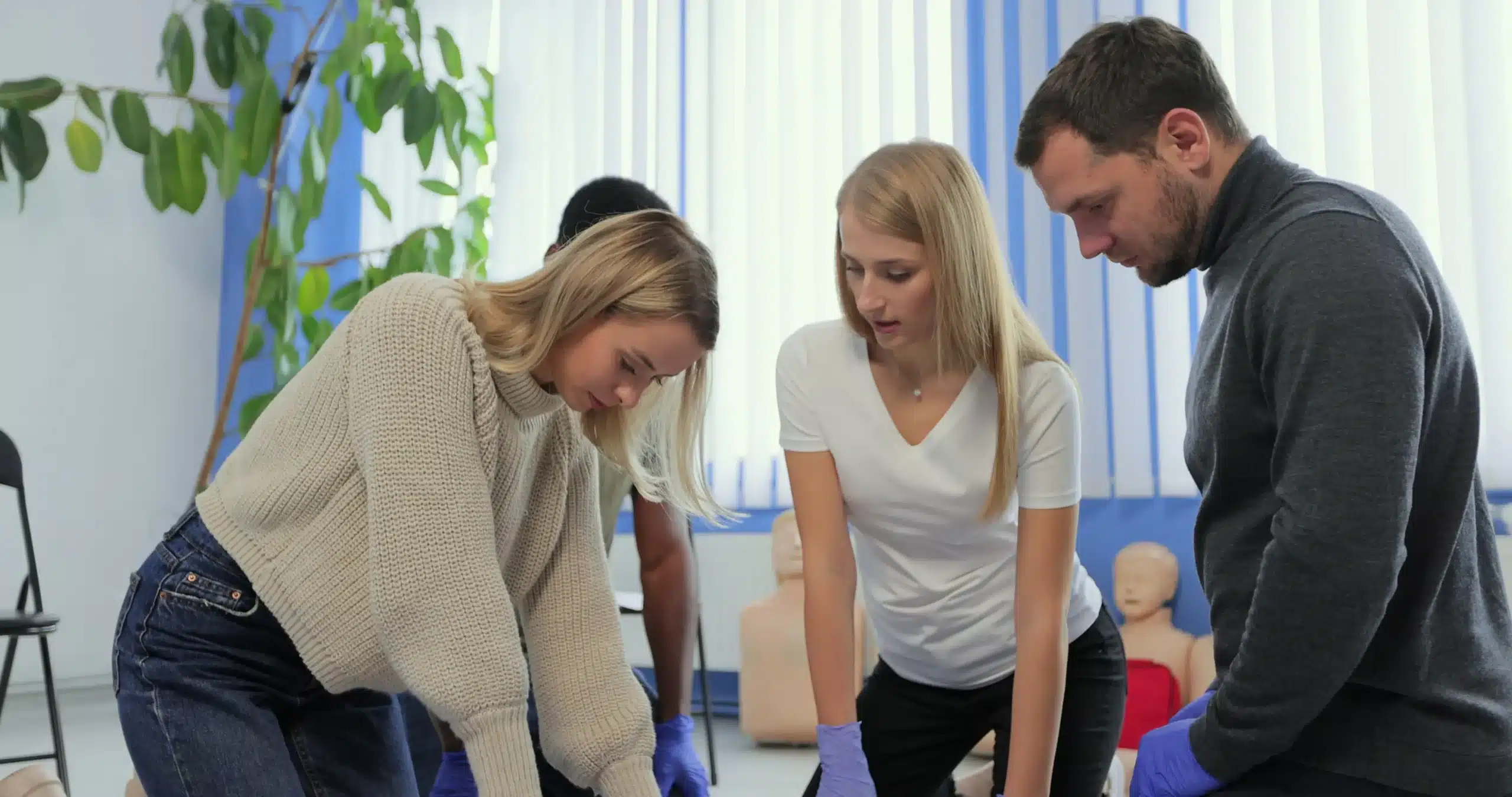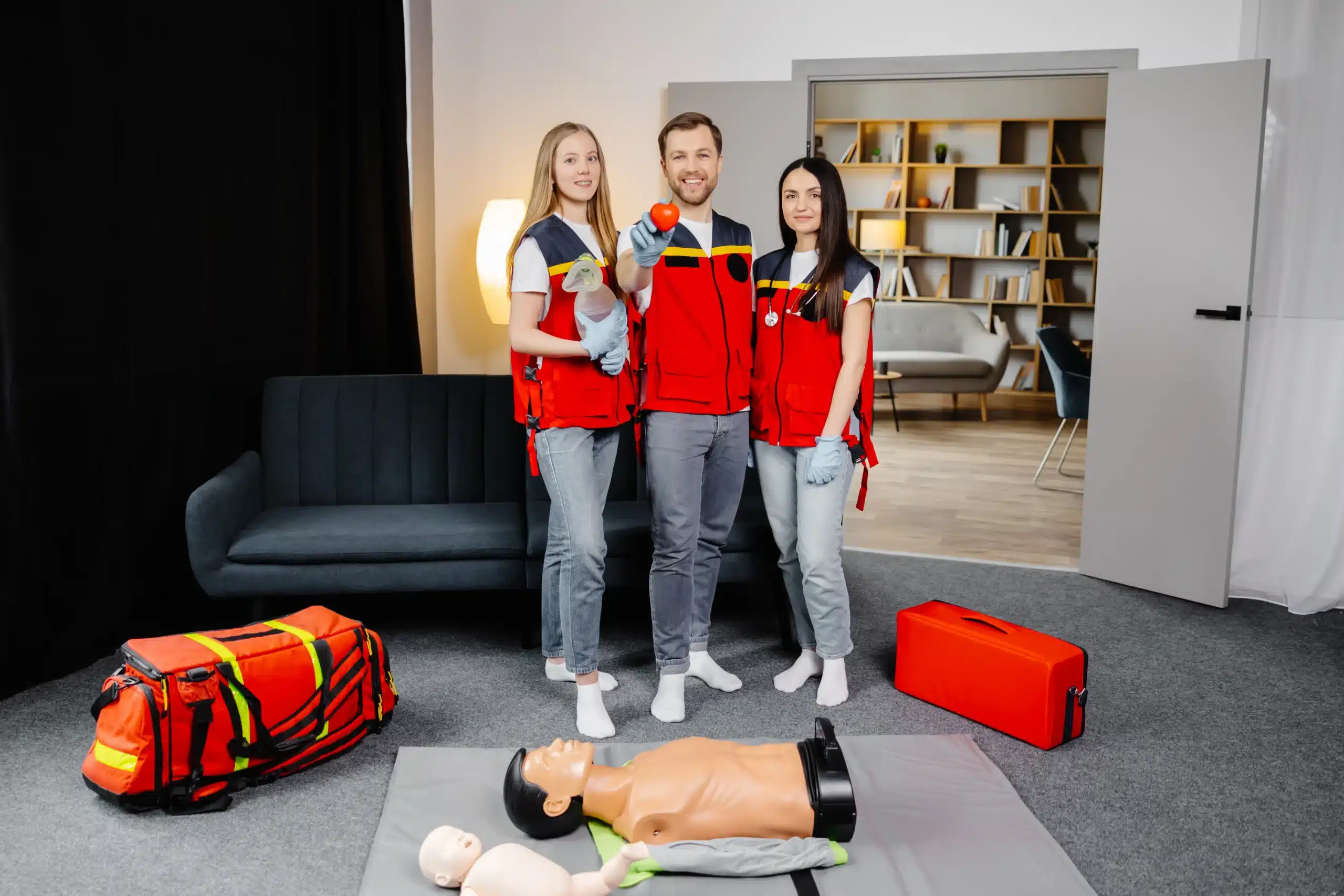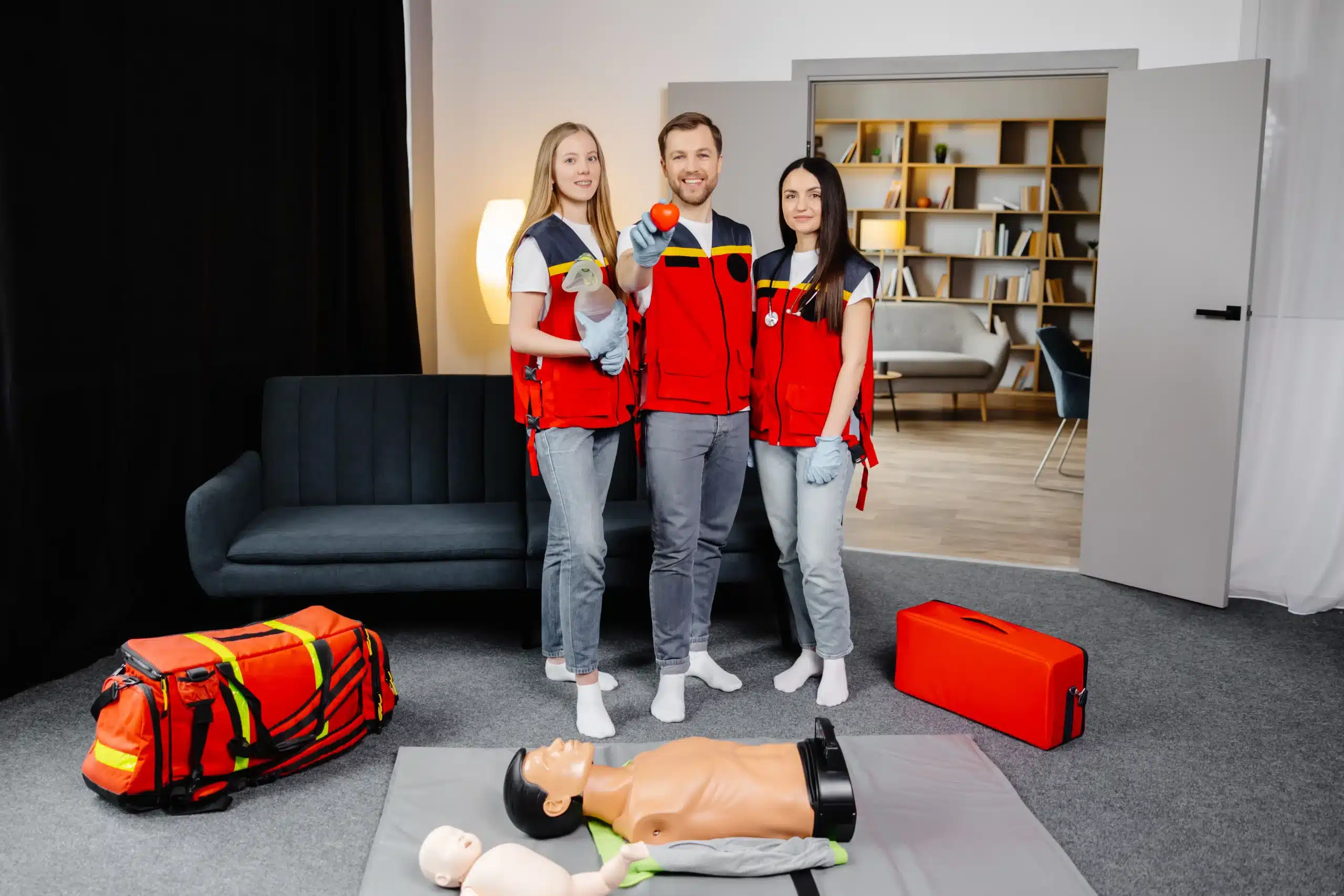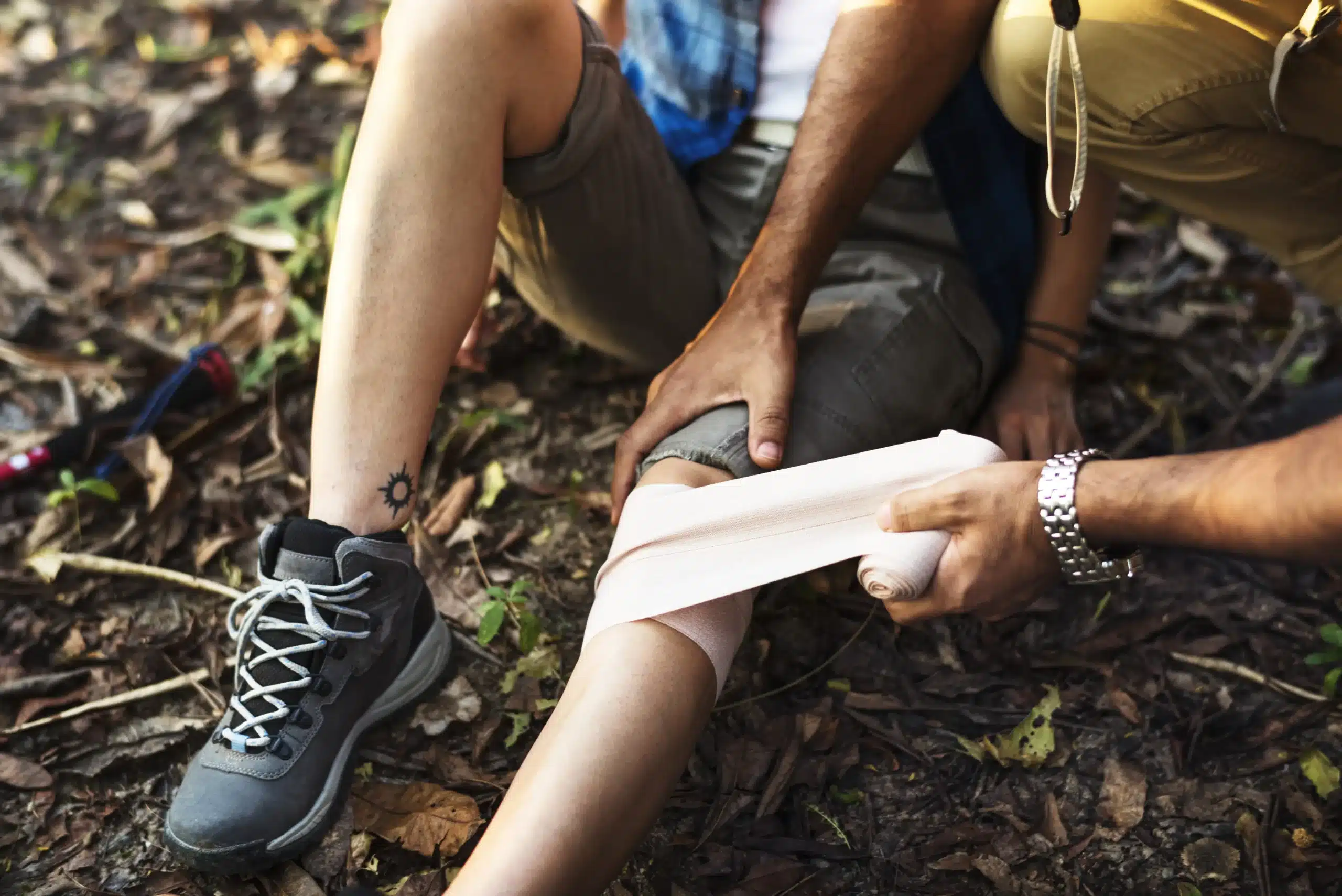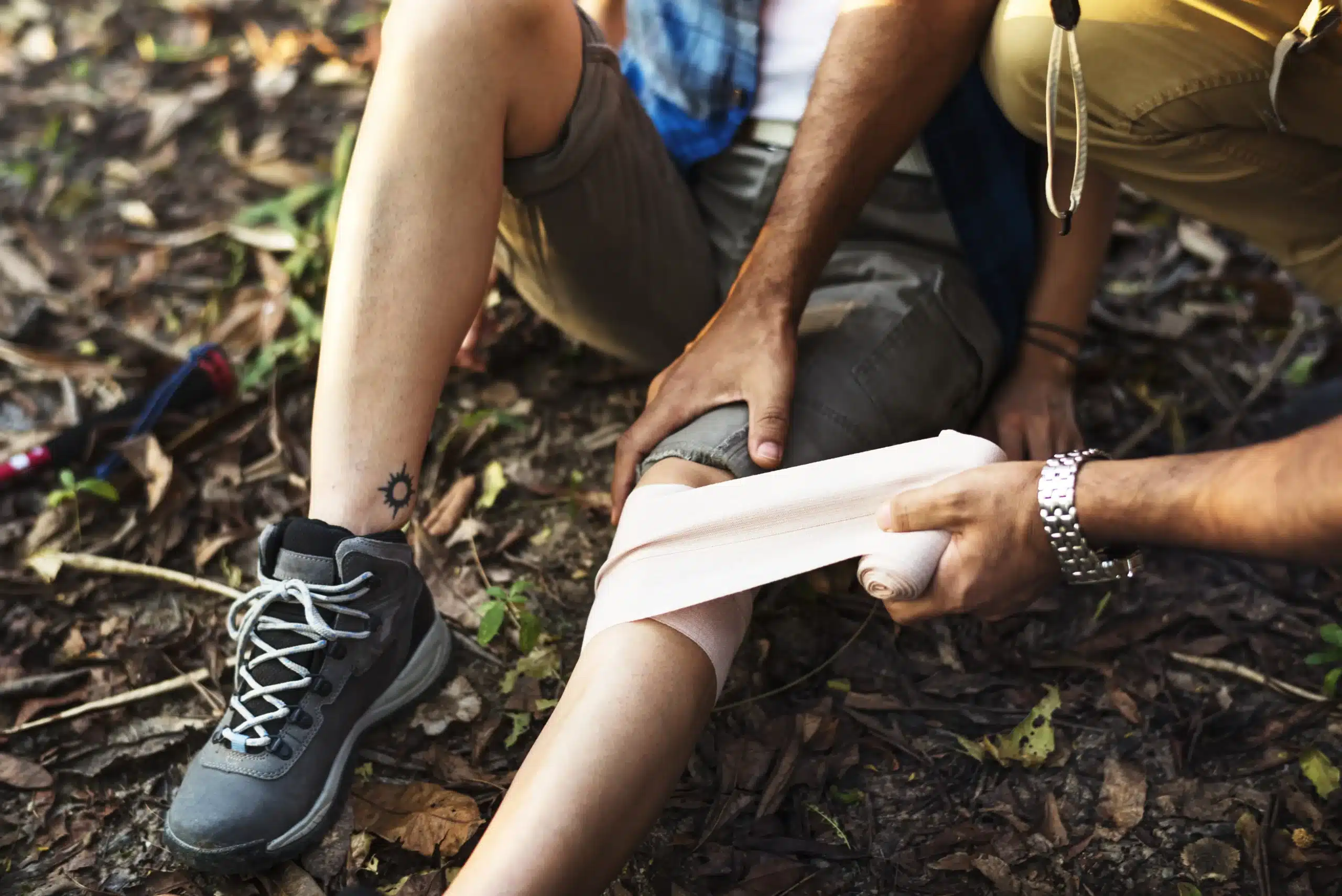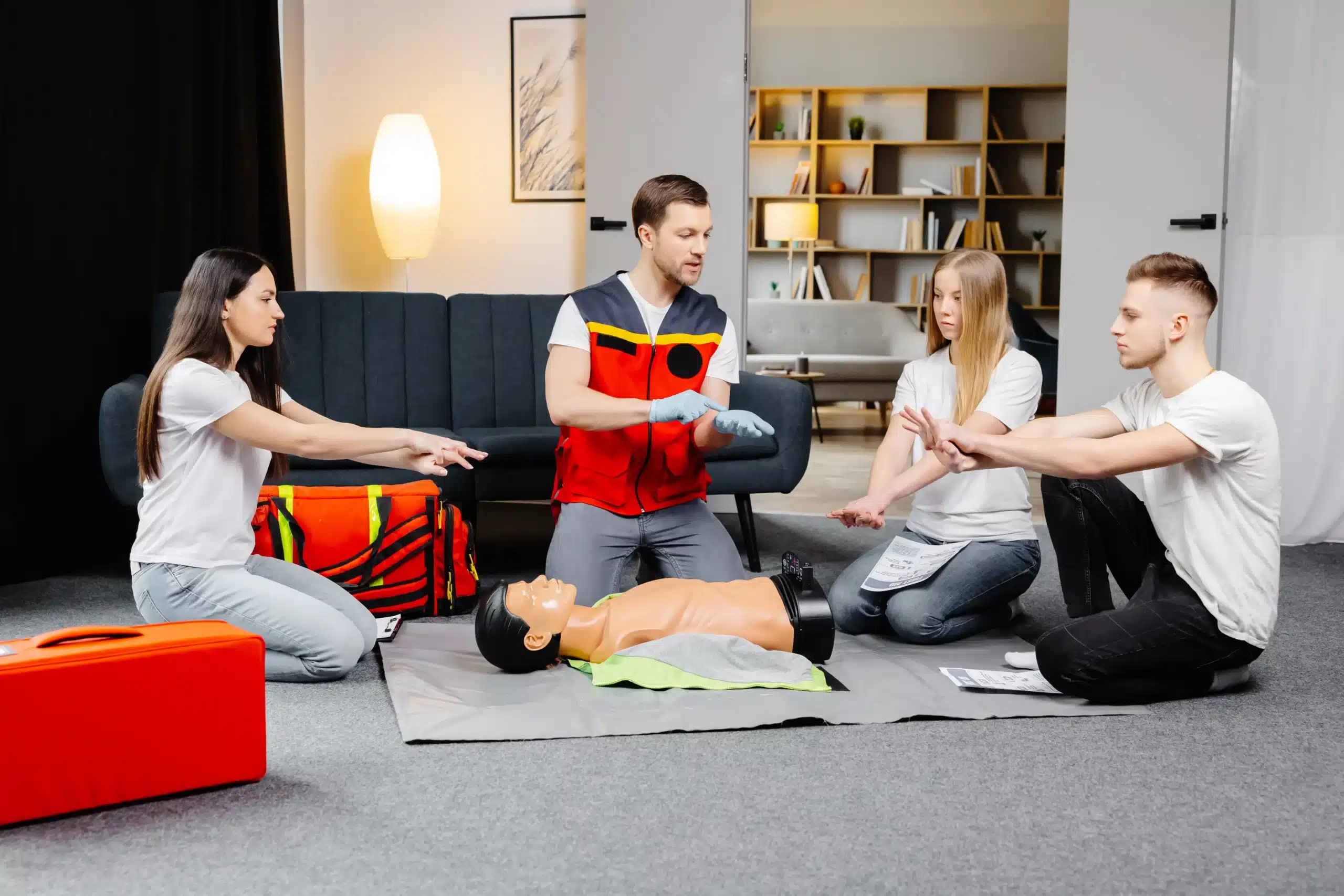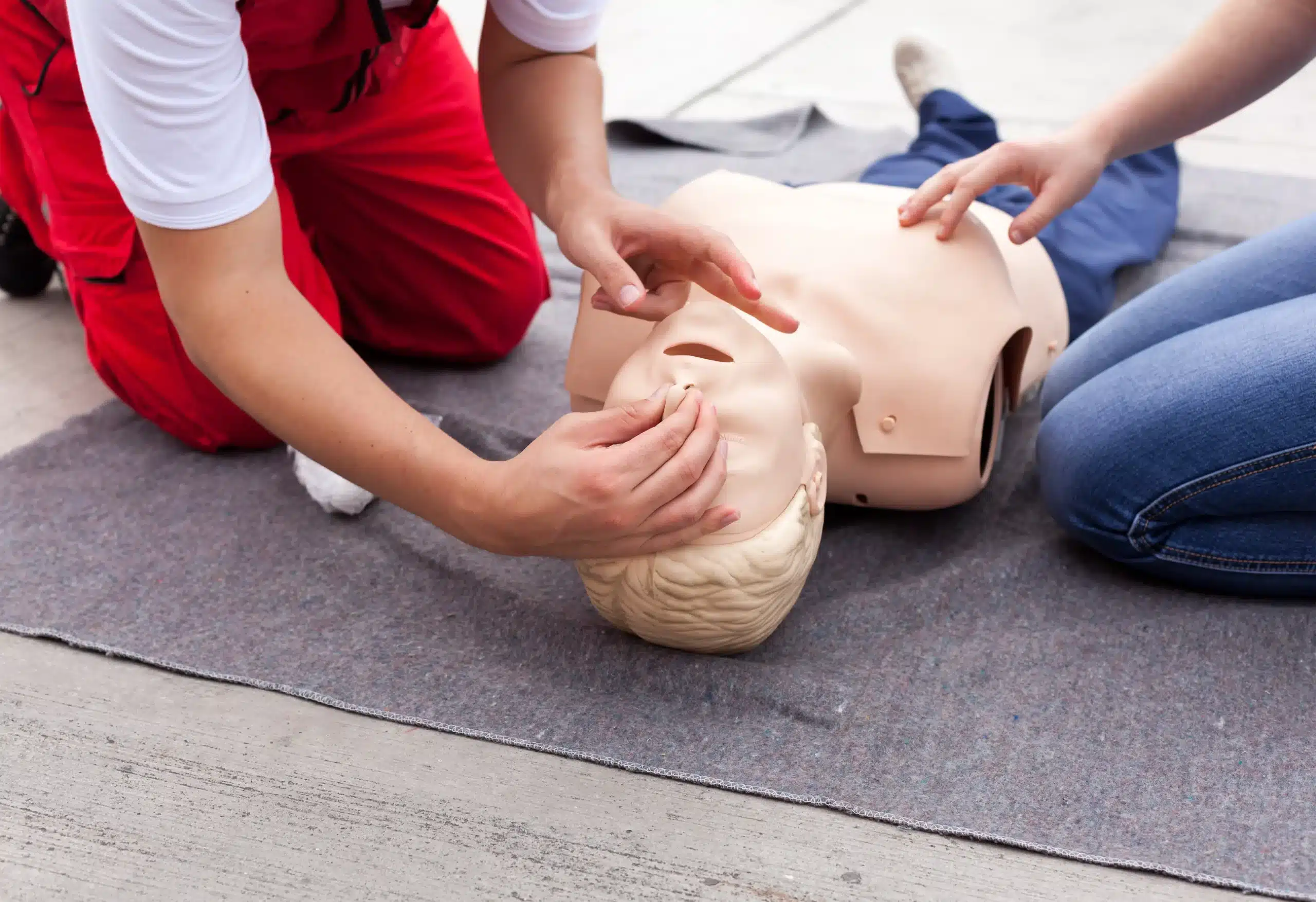Accidents happen, and being prepared can make all the difference. First-aid training empowers you to respond effectively in emergencies, providing crucial care until professional help arrives. If you’re looking for “first-aid classes near me,” this guide will help you find the right training program. We’ll explore the various types of first-aid courses available, from basic to advanced, and discuss the different certification options. We’ll also delve into the costs associated with training, the process of getting certified, and the importance of recertification. Get ready to gain valuable skills and the confidence to act when it matters most.
Key Takeaways
- First aid is for everyone: Learning first aid equips you to handle emergencies at home, in the workplace, or within your community. Find training that suits your schedule and learning preferences.
- Choose the right course: Select a reputable provider offering recognized certifications, such as the American Red Cross or American Heart Association. Compare costs and explore available discounts.
- Prepare for success: Understand certification types and their validity periods. Arrive prepared with necessary materials and consider your learning style to maximize your training experience.
What are First-Aid Classes?
First-aid classes give you the essential skills to handle medical emergencies until professional help arrives. They cover a wide range of situations, from assessing injuries and performing CPR to managing various medical crises, like recognizing the signs of a heart attack or stroke. You’ll also learn how to control bleeding, treat burns, and care for broken bones and sprains. First-aid training isn’t just for medical professionals; it’s valuable for anyone. Whether at home, work, or in the community, first-aid knowledge can make a real difference. These classes empower you to respond effectively in critical situations, potentially saving lives and lessening the severity of injuries. The hands-on practice included in many courses builds confidence so you can act quickly and calmly when it matters most. First-aid certification is available for various groups, including workplaces, schools, and community organizations. If you want to be more prepared for emergencies, consider finding a first-aid class near you.
Find First-Aid Classes Near You
Knowing where to find first-aid training can be crucial in an emergency. This section breaks down the types of courses available and how to find them in your area.
CPR and AED Training
CPR and AED training gives you the skills to respond to cardiac emergencies. Since almost 90% of these emergencies occur at home, knowing CPR can be essential for protecting your family. CPR certification often includes AED instruction, teaching you how to use this device to help restore a normal heart rhythm. Because many people feel unprepared during these events, taking a CPR/AED course can empower you to act quickly and confidently.
Basic First Aid
Basic first-aid courses cover essential skills for handling common injuries like cuts, burns, and sprains. You’ll learn how to stop bleeding, clean and bandage wounds, and manage fractures. Organizations like the American Red Cross offer various first-aid courses, often combined with CPR training for a well-rounded approach to emergency care. These courses benefit everyone, even without a medical background.
Basic Life Support (BLS)
BLS certification is generally for healthcare providers and other professionals needing more advanced first-aid and CPR training. BLS courses cover advanced life-saving techniques, including two-rescuer CPR and using bag-valve masks. Providers like Safety Training Seminars offer comprehensive BLS training that meets industry standards.
Specialized First-Aid Courses
Beyond the basics, you can find specialized first-aid courses for specific needs. These might include wilderness first aid, pediatric first aid, or instructor-level training. If you’re interested in becoming a certified instructor, resources like Online CPR Certification offer information on the process and costs. A specialized course lets you develop expertise in a particular area of first aid.
Locate Reputable First-Aid Training
Finding the right first-aid training program involves a bit of research to ensure it aligns with your needs and provides a recognized certification. Here’s how to find reputable training:
Search Online
Start with a simple online search for “first-aid training near me.” You’ll find various options, including well-established organizations like the American Red Cross, which offers diverse courses and formats. Look for programs with certifications recognized by organizations like the American Heart Association or the National Safety Council. Reading online reviews can also offer insights into other people’s experiences.
Check Local Organizations
Your local community often has excellent resources for first-aid training. Check with community centers, fire departments, hospitals, and recreation departments, as they frequently offer affordable courses. Local businesses specializing in first-aid training, like Healthline First Aid, can provide more personalized instruction.
Explore Workplace Options
Many workplaces offer first-aid and CPR training as part of their safety programs. Ask your HR department or safety manager about available opportunities. Some companies bring in certified instructors for on-site training, like CPR Certification Dallas, which makes it convenient for employees. If your workplace doesn’t offer these programs, consider suggesting it. It shows your commitment to safety and could benefit everyone.
Choose the Right Class Format
Finding the right first-aid class means picking a learning environment that truly works for you. Let’s explore the most common options so you can make the best choice for your learning style and schedule.
In-Person Training
In-person classes provide that hands-on, face-to-face experience many people find invaluable. You’ll work directly with a certified instructor, practicing essential skills in a controlled setting and receiving immediate feedback. This format is great for those who learn best through direct interaction and appreciate the structured environment of a classroom. Plus, in-person courses often meet OSHA workplace requirements, and the certifications you earn are typically valid for two years. If you thrive in a traditional learning environment and want the most comprehensive, immersive experience, in-person training might be your best bet. Consider exploring these in-person training options at Safety Training Seminars in Napa.
Online Courses
Online courses offer a flexible, self-paced alternative to traditional classroom learning. You can access the material from anywhere, at any time, using your computer, tablet, or phone. This format is ideal if you have a busy schedule, travel frequently, or simply prefer learning at your own speed. However, keep in mind that online courses typically don’t include hands-on skill demonstrations, which are essential for truly mastering first-aid techniques. If you need a flexible option and are comfortable learning independently, an online course might be a good fit. Just be sure to supplement your online learning with opportunities to practice your skills.
Blended Learning
Blended learning combines the best of both worlds, offering a balanced approach that integrates online learning with in-person skill development. You’ll complete some coursework online, enjoying the flexibility and convenience of digital learning, and then participate in hands-on practice sessions with a certified instructor. This approach is perfect for those who want the flexibility of online learning but also recognize the importance of practical, hands-on training. Blended learning provides a well-rounded experience, allowing you to learn at your own pace while still receiving personalized guidance and feedback. Healthline First Aid offers more information on the benefits of blended learning and how it can enhance your first-aid training.
Understand First-Aid Training Costs
Knowing the price range for first-aid training helps you budget effectively and find a course that fits your needs. Several factors influence the final cost, so understanding these will help you make informed decisions.
Typical Prices
CPR classes typically cost between $40 and $60 per person. More advanced training like BLS CPR and AED certification usually costs around $80. These prices vary based on location and the training organization. For example, American Heart Association (AHA) certified CPR and First Aid classes are often priced around $80. Check with various providers like CPR Certification Dallas for up-to-date pricing.
Factors Affecting Cost
Several factors influence first-aid training costs. The type of training and the certifying organization play a significant role. Becoming a certified CPR instructor requires a more substantial investment, ranging from $1,300 to $5,100, covering instructor training, certification, equipment, and materials. The American Heart Association and the American Red Cross offer various CPR class types, each with its own pricing. Compare these options to find the best fit for your goals and budget. Online CPR Certification offers a helpful breakdown of instructor training costs.
Find Discounts
Look for discounts or promotions to make your training more affordable. The Red Cross, a well-known first-aid training provider, often has promotions like free shipping on training supplies. Explore their current offers on the Red Cross Training website. Other organizations, such as Healthline First Aid, may also offer discounts or special rates. Checking their websites or contacting them directly can uncover potential savings. Remember, being cost-conscious doesn’t mean compromising on quality training.
Get Certified: What You Need to Know
So, you’re ready to take a first-aid class—fantastic! Before you sign up, here’s what you should know about getting certified.
Certification Types
First things first: understand the different types of certifications. Do you need adult CPR and First Aid training? Or are you a healthcare provider looking for BLS certification? Knowing what you need helps you find the right course. For example, Safety Training Seminars offers the American Heart Association BLS, ACLS, and PALS certifications for healthcare professionals. They also provide CPR and First Aid training, including the EMSA Child Care Health & Safety program. Look for a training provider that offers the specific certification you require.
Validity Periods
Certifications expire! Most first-aid and CPR certifications are valid for about two years. This isn’t a money-grab; guidelines and best practices change, so regular recertification ensures your skills are current. Check with your certifying organization or employer for specific recertification requirements. For instance, those needing to maintain their RQI certification will have different requirements than someone certified in standard First Aid and CPR.
Recertification
Staying certified means refreshing your knowledge and skills. Plan to recertify before your current certification expires. Many organizations offer recertification courses, often shorter than the initial training. Think of it as a tune-up to keep your life-saving skills sharp. Safety Training Seminars in Napa offers a variety of recertification courses, making it easy to stay up-to-date. Staying current not only keeps you prepared but also demonstrates your commitment to providing high-quality care.
Prepare for Your First-Aid Class
So, you’ve signed up for a first-aid class—fantastic! Now, let’s make sure you’re prepared to get the most out of your training. A little preparation goes a long way in ensuring you’re ready to learn these life-saving skills.
What to Bring
For in-person and blended learning first-aid classes, having the right materials is key. Since these courses often involve hands-on training with certified instructors, bring a notebook and pen to jot down important notes. Your instructor might also specify other required materials, so double-check any communications you’ve received from them. And of course, bring anything you need to feel comfortable, like a water bottle or a small snack. This hands-on training is often essential for meeting OSHA workplace requirements, so making the most of it is important.
Review Pre-Course Materials
Many courses provide materials you can review beforehand. Take advantage of this! Familiarizing yourself with the content ahead of time, even briefly, can make the in-class learning experience much more effective. If you’ve opted for an online course, you’ll likely have access to all the materials digitally. Online courses offer a lot of flexibility, letting you learn at your own pace from your computer or phone. However, remember that online formats typically don’t include the hands-on skill demonstrations that are so valuable in a classroom setting.
Get Ready
Before you head to class (virtual or in-person!), take a moment to consider your learning style. Think about what helps you absorb information best. Do you learn best by listening, watching, or doing? This will help you engage actively with the course content. Being prepared ensures you’re ready to apply your new skills effectively. Remember, proper first aid can make a real difference in preventing further complications and alleviating pain, so your preparation is a crucial first step. If you’re looking for in-person training in Napa, check out the courses offered by Safety Training Seminars. We offer a range of options to fit your needs.
Debunk First-Aid Myths
Let’s clear up some common misconceptions about first aid. These myths can be dangerous, so understanding the facts is crucial.
Myth: First Aid is Only for Medical Professionals
It’s a common misconception that first aid is solely the domain of doctors and nurses. Absolutely not! First aid is for everyone. Knowing basic first aid can empower you to help family, friends, coworkers, or even strangers in need. Everyday people are often the first on the scene of an accident, and having these skills can make a real difference before professional help arrives. As Solid Rock Health points out, first aid and CPR are important skills for everyone to learn.
Myth: You Shouldn’t Move an Injured Person
While it’s generally true that you shouldn’t move someone with a potential spinal injury, there are exceptions. If the person is in immediate danger—say, a burning car or a building about to collapse—moving them becomes necessary. Knowing how to move someone safely in these situations can prevent further injury. MyCPR NOW highlights how misconceptions about first aid can have serious consequences, emphasizing the importance of accurate knowledge.
Myth: Applying Butter to Burns is Helpful
Please, never put butter on a burn! This old wives’ tale can actually worsen the injury. Butter traps heat against the skin, leading to deeper damage. Cool the burn with cool (not icy) water and seek medical attention. MyCPR NOW explains how applying substances like butter to burns can worsen the injury and delay proper treatment.
Myth: CPR is Only for Cardiac Arrest
CPR is indeed commonly associated with cardiac arrest, but it can also be used for other breathing emergencies, such as near-drowning or choking. Learning CPR equips you to respond to a wider range of life-threatening situations. By Grace CPR Compliance emphasizes that CPR and first aid are critical skills that can make a life-or-death difference, highlighting their broad application.
Myth: First Aid Training is Not Necessary for Minor Injuries
Even seemingly minor injuries can benefit from proper first aid. A small cut can become infected without proper cleaning, and a minor sprain can be more comfortably managed with the right techniques. Mainland Safety emphasizes the importance of first aid for all injuries, stating that dispelling these common myths about first aid is crucial. Learning first aid empowers you to handle any injury effectively and confidently.
Explore Top First-Aid Class Providers
Finding the right first-aid class often means choosing a reputable provider with a history of quality training. Here are a few well-known organizations and local resources to consider:
Safety Training Seminars in Napa
If you’re in the Napa area, Safety Training Seminars offers a variety of first-aid and CPR training courses designed for individuals and organizations. They focus on providing students with essential, practical life-saving skills. Their convenient Napa location serves Napa, American Canyon, and Vallejo, CA. They offer courses such as American Heart Association BLS, ACLS, PALS, and more. They also offer EMSA Child Care Health & Safety and RQI classes.
American Red Cross
The American Red Cross is a trusted name in first-aid and CPR training. With courses available online, in person, and in blended formats, you can find an option that fits your schedule. In-person and blended learning courses provide hands-on training and meet OSHA workplace requirements. For more details on certification, visit the Red Cross website.
American Heart Association
The American Heart Association (AHA) also offers a range of first-aid, CPR, and AED training through various providers. You can find AHA-certified courses covering everything from basic life support (BLS) to advanced cardiovascular life support (ACLS) and pediatric advanced life support (PALS). Many local training centers partner with the AHA to deliver these crucial courses.
National Safety Council
The National Safety Council provides a variety of first-aid training programs geared toward different audiences. They offer workplace safety training, as well as specialized courses for healthcare professionals and first responders.
Local Hospitals and Medical Centers
Many local hospitals and medical centers offer first-aid and CPR training classes open to the community. These classes are often tailored to specific needs, such as pediatric first aid or workplace safety. Check with hospitals in your area to see what they offer.
Community Colleges
Community colleges frequently offer first-aid and CPR certification courses through their continuing education programs. This can be a convenient and affordable way to get certified. Check with your local community college for course schedules and registration information.
Discover the Benefits of First-Aid Training
Learning first aid offers a range of advantages, from personal growth to community impact. It’s about more than just acquiring a skill set—it’s about empowering yourself and others to handle emergencies effectively.
Build Confidence and Skills
First aid training equips you with the practical skills to confidently respond to various medical situations. High-quality courses go beyond the basics, dispelling common first-aid myths and providing hands-on practice. This builds your confidence and reduces hesitation in real emergencies. Knowing how to assess a situation, control bleeding, or administer CPR can make a critical difference, providing immediate care until professional help arrives.
Improve Workplace Safety
First aid training is invaluable in any workplace. Equipping employees with these skills creates a safer work environment. Basic first aid training covers essential procedures applicable in various settings. Trained employees can respond quickly to incidents, minimizing the severity of injuries and preventing further complications. This proactive approach protects employees and reduces workplace downtime and potential liability.
Make a Community Impact
First aid training extends beyond personal and professional benefits; it strengthens the entire community. When more people are trained, the community becomes better equipped to handle emergencies. Promoting first-aid education improves community preparedness. Organizing community first-aid training empowers individuals to assist others during crises. This collective knowledge creates a network of support, fostering a safer and more resilient community.
Related Articles
- First Aid Classes Napa: Your Complete Guide – Napa CPR Classes
- First Aid in American Canyon: A Guide to Certification
- Your Guide to CPR Training in American Canyon – Napa CPR Classes
- BLS Training in Vallejo: Your Go-To Guide – Napa CPR Classes
- First Aid in Napa: Your Guide to Local Training – Napa CPR Classes
Frequently Asked Questions
What’s the difference between basic first aid and CPR?
CPR focuses specifically on life-threatening breathing and cardiac emergencies, while basic first aid covers a broader range of injuries and illnesses, from cuts and burns to sprains and allergic reactions. Think of CPR as a specialized skill within the larger umbrella of first aid.
How do I choose the right first-aid class?
Consider your specific needs and learning style. If you’re looking for basic skills, a standard first-aid and CPR course might suffice. Healthcare providers typically require more advanced certifications like BLS. Think about whether you prefer in-person instruction, the flexibility of online learning, or a blended approach. Also, check if the certification aligns with any workplace requirements.
How much does first-aid training cost, and how can I find affordable options?
Costs vary depending on the course type, location, and training provider. Basic first aid and CPR classes usually range from $40 to $80. More specialized courses, like BLS or wilderness first aid, can be more expensive. Look for discounts or promotions offered by training organizations or check with local community centers and hospitals, which may offer lower-cost options.
How long are first-aid certifications valid, and how do I recertify?
Most first-aid and CPR certifications are valid for two years. Recertification involves taking a refresher course to update your skills and knowledge according to the latest guidelines. Contact your certifying organization or check their website for recertification requirements and available courses.
What if I’m nervous about using my first-aid skills in a real emergency?
It’s completely normal to feel apprehensive. That’s why quality training programs emphasize hands-on practice and realistic scenarios. This builds confidence and helps you react effectively under pressure. Remember, any first aid you can provide is better than none. Your training will equip you to make a difference.
